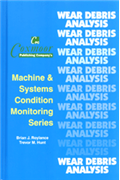Description
With over 70 illustrations, figures and tables, this book is a very inclusive reference. It gives a practical look at wear debris and wear particle analysis in many forms.
Author:
Brian J. Roylance and Trevor M. HuntFormat:
HardbackPages:
127Excerpt:
Trend Analysis"Trend Analysis is the process by which a change in machine condition is determined from an examination of changes in specific sensors or output.
"Different systems exhibit different trends. For instance, the wear debris generated from a system involving gears and bearings may well be quite high initially, particularly if no attempt has been made to 'run-in' the system. Thus there is a gradually reducing level of debris until the system settles in. Then comes the acceptable very low wear rate associated with well lubricated surfaces, which perhaps increases just slightly. Finally, the machine begins to show signs of fatigue or fracture and particle generation increases at an ever increasing rate. These three stages of wear are shown in the classical 'Bath-tub" curve.
"Another changing feature of wear with time, is that the wear rate begins to fluctuate. After the 'running-in' period, the wear rate is expected to be reasonably uniform, although it may rise slightly. However, as conditions begin to become less favourable wear may be less or more in terms of particle size generation as well as with total quantity. Scatter is thus seen as a trend indicator.
"The third sort of trend indication is that associated with the shape of particle - its morphology. This is less easy to measure than the gravimetric level or 'size' of particulate; but, by using the analysis mentioned later in this chapter for defining particle shape, two or more possible specific indicators of shape may be trended to detect the point at which a serious change in debris particle shape occurs."
"Different systems exhibit different trends. For instance, the wear debris generated from a system involving gears and bearings may well be quite high initially, particularly if no attempt has been made to 'run-in' the system. Thus there is a gradually reducing level of debris until the system settles in. Then comes the acceptable very low wear rate associated with well lubricated surfaces, which perhaps increases just slightly. Finally, the machine begins to show signs of fatigue or fracture and particle generation increases at an ever increasing rate. These three stages of wear are shown in the classical 'Bath-tub" curve.
"Another changing feature of wear with time, is that the wear rate begins to fluctuate. After the 'running-in' period, the wear rate is expected to be reasonably uniform, although it may rise slightly. However, as conditions begin to become less favourable wear may be less or more in terms of particle size generation as well as with total quantity. Scatter is thus seen as a trend indicator.
"The third sort of trend indication is that associated with the shape of particle - its morphology. This is less easy to measure than the gravimetric level or 'size' of particulate; but, by using the analysis mentioned later in this chapter for defining particle shape, two or more possible specific indicators of shape may be trended to detect the point at which a serious change in debris particle shape occurs."
Table Of Contents:
-
Introduction to wear debris Analysis
- Introduction
- Overall View of Methods
- Choice
- Type of Connection
- Type of Preparation
- Type of Analysis
- Scope
-
Basic Concepts and Theory
- Quantity and Size
- Trend Analysis
- Absolute Levels
- Visual Identification-Shape
- Systematic Particle analysis
- Wear and wear particles
- Wear particle atlas (WPA)
- Computer-aided systematic particle analysis (CASPA)
- Computer-aided vision engineering (CAVE)
- Composition
- Origins
- Spectometric Identification
-
Practical Issues
- Sampling
- Position
- Preparation
- Time
- Grease
- Analysis
- In-line and on-line analysis
- Off-line analysis
- Reporting
-
Equipment and Instrumentation
- Sampling points and probes
- Sample points
- Sample probes
- Samplers
- Patch Making
- On-line conpar
- Off-line Millipore
- Patch Analysers, Including image analysis
- Comparative analysis
- Automatic analysis
- Image analysis
- Wear debris atlases
- Off-line Debris Detectors, including ferrography
- Ferrous debris
- All metal debris
- All debris
- Off-Line particle analysers, including counters
- Optical
- Acoustic Spectroscopy
- In-Line Debris Detectors
- Magnetic/conductance
- Magnetic/inductance
- Thin Film Wear and Radioctivation
- Mesh/Conductance
- In-Line Particle Analysers, including counters
- Inductance
- Ultrasonics
- On-Line Debris Detectors
- Electrical conductance
- Magnetic attraction
- Optical time of transition
- Thin film wear
- On-Line Particle Analysers, including counters
- Filter blockage
- Inductance
- Optical obscuration
- Ultrasonics
- Spectrometry
- Kits
-
Applications and Case Studies
- Applications
- General Comments
- Appropriate systems and machinery
- Why wear debris analysis is so successful
- Case Studies
- Experimental testing
- Individual tests
- In-line metal detection using the ODM
- Comparitive tests
- Loaded bearing rig, using vibration, temperature, spectroscopy, ultrasonics and WDA
- Industrial use
- Individual tests
- Marine gear box using the MPD
- British Rail rolling stock using spectroscopy
- 1000 ton press using the CSI Oil View
- Hydraulic robot using filter blockage
- Marine diesel engines using Ferrography
- Comparative tests
- Coal mill gearboxes using vibration, oil analysis and WDA
- Gear drive of a cement plant mill using vibration and WDA (RPD)
-
Buyer's Guide
- Companies (including oil analysis)
- Equipment & Instrumentation
- Services, Laboratories, Consultants, & Training
-
Reference
- Glossary of Terms
- Tables
- Compatibility of membrane filters with liquids
- References
- Bibliography




